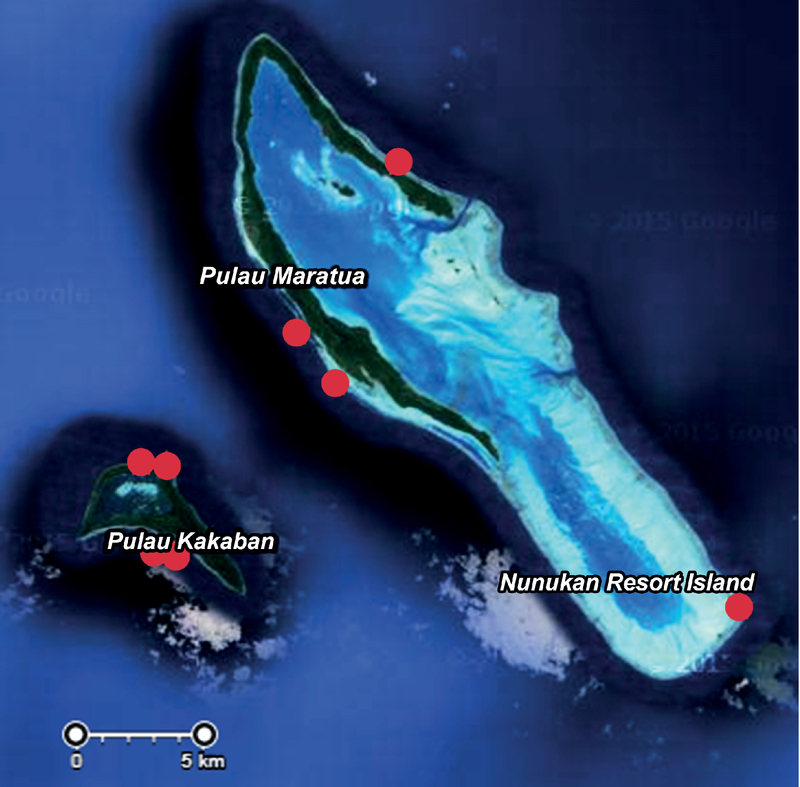Geometry Morphometry and Health Status of Hawksbill Turtle (Eretmochelys imbricata Linnaeus, 1766) in Maratua Island, East Kalimantan-Indonesia
DOI:
https://doi.org/10.18502/kls.v3i4.693Abstract
Research on hawksbill turtles in the Maratua Island is still very few. Meanwhile, population of hawksbills was believed to decline due to human exploitation. The aim of this research was to study the morphology of hawksbill through geometric morphometric approach and health status which includes the existence of epibionts, mechanical damages and Body Condition Index. The survey was conducted from 5 to 18 September 2014. The method used was the hand˗catching by snorkeling and diving for catching turtles, morphometric measurements and documentation of the turtle body parts using the camera. Morphological aspects were analyzed with linear regression and geometry approach with Microsoft Excel and ImageJ software. Health status was analyzed with observation of epibionts and mechanical damages through photos and calculation of Body Condition Index. There were 11 turtles that have been caught. The results indicated the growth of straight carapace length notch to tip affect the growth of the other body parts of hawksbill turtle and based approach to geometry, shape growth of hawksbill turtles that are found in Maratua not changed but only have added size. Based on the health status through observation epibionts, mechanical damages and analysis of Body Condition Index, hawksbill in Maratua still relatively healthy compared with studies elsewhere.
Keywords: Eretmochelys imbricata (Linnaeus, 1766); geometry; Maratua; morphometry
References
A. Al Giffari, “Partisipasi masyarakat dalam program konservasi penyu (Kasus I kawasan konservasilLaut Kabupaten Berau, Kepulauan Derawan, Provinsi Kalimantan Timur, [Participant of community in turtle conservation programme (Case I coservation sea area in Berau District, Derawan Island, East Borneo Province)],
[Undergraduated thesis],” Institut Pertanian Bogor, 2008.
A. Rahman and R. Basuki, “Materi penyuluhan kelautan dan perikanan konservasi biota terancam punah Penyu Sisik. [Sea counseling and fisheries conservation biota endangered Hawksbill Turtle material]., Jakarta,” Kementrian Kelautan dan Perikanan Badan Pengembangan SDM Kelautan dan Perikanan Pusat Penyuluhan
Kelautan dan Perikanan, pp. 18–19, 2011, [in Bahasa Indonesia].
EG. Wilson, KL. Miller, D. Allison, and M. Magliocca, “Why healthy oceans need sea turtles: the importance of sea turtles to marine ecosystems,” Why healthy oceans need sea turtles: the importance of sea turtles to marine ecosystems, p. 7, 2010.
J. M. Daza and V. P. Páez, “Morphometric variation and its effect on reproductive potential in female Colombian slider turtles (Trachemys callirostris callirostris),” Herpetologica, vol. 63, no. 2, pp. 125–134, 2007.
GIWA, “Freshwater shortages, engineering of river flows, pollution and overfishing highlighted in final global international waters assessment. Nairobi: United Nations Environment Programme,” p. 58, 2006.
M. A. Stamper, C. Harms, S. P. Epperly, J. Braun-McNeill, L. Avens, and M. K. Stoskopf, “Relationship between barnacle epibiotic load and hematologic parameters in loggerhead sea turtles (Caretta caretta), a comparison between migratory and residential animals in Pamlico Sound, North Carolina,” Journal of Zoo and Wildlife
Medicine, vol. 36, no. 4, pp. 635–641, 2005.
R. P. Van Dam and C. E. Diez, “Caribbean hawksbill turtle morphometrics,” Bulletin of Marine Science, vol. 62, no. 1, pp. 145–155, 1998.
M. Flint, J. Patterson?Kane, P. Mills, and C. Limpus, “A Veterinarians guide for Sea Turtle post mortem examination and histological investigation,” in PattersonKane J, p. 21, Queensland, The University of Queensland, 2009.
J. M. Blumenthal, T. J. Austin, C. D. L. Bell et al., “Ecology of hawksbill turtles, Eretmochelys imbricata, on a western caribbean foraging ground,” Chelonian Conservation and Biology, vol. 8, no. 1, pp. 1–10, 2009.
US. Fish, “Wildlife Service. South Florida multi-species recovery plan,” in h and Wildlife Service, p. 615, U.S. Fish, Atlanta, Georgia, 1999.
MG. Frick, PA. Mason, KL. Williams, K. Andrews, and H. Gerstung, “Epibionts of Hawksbill Turtle in a Caribbean nesting ground: A potentially unique association with snapping shrimp (Crustacea: Alpheidae). Marine Turtle Newsletter,” in Gerstung H. Epibionts of Hawksbill Turtle in a Caribbean nesting ground: A potentially unique association with snapping shrimp (Crustacea: Alpheidae). Marine Turtle
Newsletter, p. 99, 99, 8–11, 2003.
OS. Ling and MP. Puspa, “Silent Turtle Dwellers: Barnacles on resident Green Turtle (Chelonia mydas) and Hawksbill Turtle (Eretmochelys imbricata) of Mabul and Sipadan Islands. Borneo Science,” in Puspa MP. Silent Turtle Dwellers: Barnacles on resident Green Turtle (Chelonia mydas) and Hawksbill Turtle (Eretmochelys imbricata) of Mabul and Sipadan Islands. Borneo Science, pp. 28–66, 28, 66–71, 2011.
M. T. Schärer, “A survey of the epibiota of Eretmochelys imbricata (Testudines: Cheloniidae) of Mona Island, Puerto Rico,” Revista de Biologia Tropical, vol. 51, no. 4, pp. 87–90, 2003
KA. Dobbs and AM. Jr Landry, “Commensals on nesting Hawksbill Turtles (Eretmochelys imbricata,” Memoirs of the Queensland Museum, pp. 649–674, 2004.
R. Hayashi, “First documentation of the barnacle Fistulobalanus albicostatus (Cirripedia: Balanomorpha) as an epibiont of loggerhead sea turtle Caretta caretta,” Marine Biodiversity, vol. 47, pp. 157–158, 2017.
E. Nájera-Hillman, J. B. Bass, and S. Buckham, “Distribution patterns of the barnacle, Chelonibia testudinaria, on juvenile green turtles (Chelonia mydas) in Bahia Magdalena, Mexico,” Revista Mexicana de Biodiversidad, vol. 83, no. 4, pp. 1171–1179, 2012.
K. A. Bjorndal and A. B. Bolten, “Hawksbill sea turtles in seagrass pastures: Success in a peripheral habitat,” Marine Biology, vol. 157, no. 1, pp. 135–145, 2009.
C. E. Diez and R. P. Van Dam, “Habitat effect on hawksbill turtle growth rates on feeding grounds at Mona and Monito Islands, Puerto Rico,” Marine Ecology Progress Series, vol. 234, pp. 301–309, 2002.

